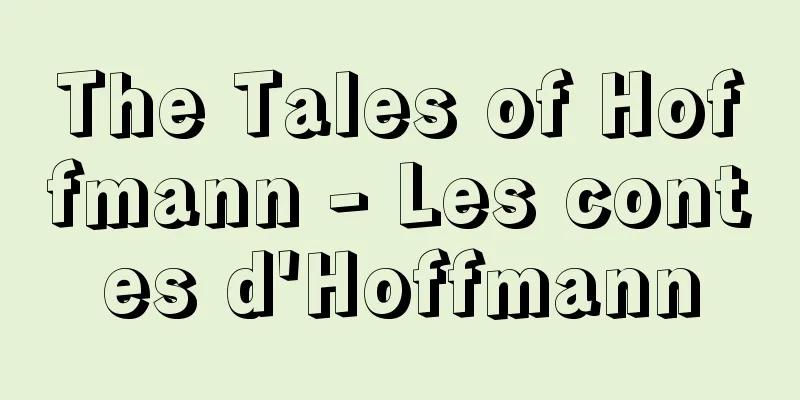Free trade - jiyuboueki (English)

|
The abolition of state interference in trade transactions, such as quantitative restrictions, tariffs, and export subsidies, and the freedom to import and export. The ideas and policies that seek to achieve this are called free trade ideology and free trade policies. [Kisuke Tanaka] History of free tradeFree trade emerged as a criticism of mercantilist trade control policies, and its theory was developed by British classical economists. A. Smith, the founder of the classical school, advocated free economic activity by individuals unconstrained by the state, in other words, laissez-faire, and believed that liberal competition increases production and promotes human welfare. His theory of free trade applied and explained this free competition to the aspect of international trade, and was the first to elucidate the benefits of international division of labor. This was clarified by D. Ricardo as the theory of comparative production costs, and became the basic principle of international division of labor in theory, and the theoretical basis of free trade in policy. British industry developed rapidly due to the progress of the Industrial Revolution, which began around the time Smith's The Wealth of Nations was published (1776). For further development, it was necessary to increase the export of industrial products and import raw materials and grains more cheaply. However, in the England of Smith and Ricardo's time, there were relics of mercantilism such as the Corn Laws, the Navigation Acts, and numerous import tariffs, and it was not easy to abolish them and achieve free trade. Britain's free trade took about 40 years to achieve, going through the free trade movement resulting from the London Merchants' Petition in 1820 and the formation of the Corn Law Repeal League in 1839, and finally reaching completion with W. E. Gladstone's tariff reform in 1860. After the Napoleonic Wars (1793-1815), Britain issued huge public bonds and introduced and raised tariffs in order to increase revenue, but the new merchants and industrialists could not bear the burden of these tariffs and submitted a petition to Parliament requesting a reduction in tariffs. This became the driving force behind the free trade movement, and the Corn Law Repeal League, led by R. Cobden and J. Bright, developed a movement centered around the Manchester Chamber of Commerce. These efforts led to a move in British policy towards free trade, which resulted in the realization of the first tariff reform (1823-25) and the second tariff reform (1842-46), as well as the repeal of the Corn Laws, said to be the two main pillars of mercantilist policy, in 1846 and the Navigation Acts in 1849. Subsequently, large-scale tariff reforms in 1853 and 1860 by Gladstone, who was Chancellor of the Exchequer in a Liberal cabinet, established the free trade system in both name and reality, and became a driving force behind the subsequent liberalization of global trade. However, the Great Depression that began worldwide at the end of 1929 dealt a major blow to the free trade system. In response to the depression, the United States and many other countries raised tariffs and implemented trade restrictions, and Britain also enacted the protectionist General Tariff Act in 1932 and launched the Commonwealth System of Preferences, eventually abandoning its free trade policy. [Kisuke Tanaka] Free Trade after World War IIAfter World War II, the General Agreement on Tariffs and Trade (GATT) was established in 1947 under the strong leadership of the United States, reflecting on the bitter experiences of countries around the world, such as the escalation of tariff barriers during the global depression of the 1930s, the introduction of all manner of trade restrictions such as import quotas, which led to a sharp decline in world trade and the formation of economic blocs to secure markets. GATT's goal was to develop world trade based on the principles of free trade and most-favored-nation treatment, and it halted protectionist movements and promoted trade liberalization on a global scale by holding seven general tariff negotiations between 1947 and 1979 to lower tariffs and eliminate non-tariff barriers such as quantitative restrictions on trade. However, the free trade system based on GATT was threatened by the decline of the US economic dominance, economic stagnation in the European Community (EC, the predecessor of the EU), the rise of protectionism as newly industrializing countries (such as South Korea, Taiwan, and Hong Kong) caught up with developed countries, and the United Nations Conference on Trade and Development (UNCTAD) demanding revisions to the GATT principles. The Uruguay Round (1986-1993), which began after the Tokyo Round, discussed a wide range of trade issues, including not only the reduction of tariffs but also the reduction and elimination of non-tariff barriers such as quantitative restrictions, and the WTO Agreement was concluded during this round. In 1995, the World Trade Organization (WTO) was established as the official organization to implement the results agreed upon there, and GATT was succeeded by the WTO. [Kisuke Tanaka] Kitano Daikichi, History of the British Free Trade Movement (1943, Nippon Hyoronsha) ▽ Fujii Shigeru, Trade Policy (1977, Chikura Shobo) ▽ Henry George, Free Trade or Protectionism (1990, Nippon Keizai Hyoronsha) ▽ Nakamura Yoichi (ed.), The World Trade Organization (WTO) Will Change Trade: Japan and the World After the Uruguay Round (1994, Toyo Keizai Shinposha) ▽ Shinbori Satoshi, Trade System and Trade Policy After the Uruguay Round (1994, Sanrei Shobo) ▽ Kojima Kiyoshi, Applied International Economics: Free Trade System (1994, Bunshindo) ▽ Tim Lang and Colin Hinds, Challenging the Myth of Free Trade (1995, Ie no Hikari Kyokai) ▽ "Cutting Down the World Trade Organization (WTO) by Sumi Kazuo (1996, Meiso Publishing)" ▽ "Trade Policy and International Trade Relations by Akiyama Kenji (1998, Dobunkan Publishing) " ▽ "Learn Economics Through Fables: Why Free Trade is Necessary" by Russell D. Roberts, translated by Sasaki Jun (1999, Nihon Keizai Shimbun)" ▽ "A History of Free Trade Theory: Against the Tide by Douglas A. Irwin, supervised by Kojima Kiyoshi and translated by Asada Shiro (1999, Bunshindo)" ▽ "Freedom and Protection: A History of British Trade Policy" by Hattori Masaharu, revised and expanded edition (2002, Nakanishiya Publishing)" ▽ "Collection of Basic Economic Treaties edited by Kodera Akira and Nakagawa Junji (2002, Yuhikaku)" ▽ "For those who study trade theory, edited by Yuhei Ogawa, new edition (2002, Sekai Shisosha) " "American trade policy, by Takao Sasaki (Iwanami Shinsho)" [References] | | | | | | | | | | | | |Source: Shogakukan Encyclopedia Nipponica About Encyclopedia Nipponica Information | Legend |
|
貿易取引に対する数量制限、関税、輸出補助金などの国家の干渉を廃止し、自由に輸出入を行うこと。これを実現しようとする思想や政策のことを自由貿易主義、自由貿易政策という。 [田中喜助] 自由貿易主義の沿革自由貿易主義は重商主義的貿易統制政策に対する批判として発生したものであり、その理論はイギリスの古典学派の経済学者によって展開された。古典学派の祖であるA・スミスは、国家に束縛されない個人の自由な経済活動、つまり自由放任主義を主張し、自由主義的な競争こそが生産を増加し、人間の福祉を増進すると考えた。この自由な競争を国際貿易の面に適用し説明したのが彼の自由貿易論であり、国際分業の利益を初めて解明したものであった。これは比較生産費説としてD・リカードにより明確化され、理論的には国際分業の基本原理となり、政策的には自由貿易主義の理論的根拠となった。スミスの『国富論』が出版された当時(1776)から始まった産業革命の進展により、イギリスの工業は急速に発達してきた。さらにいっそうの発展のためには、工業品の輸出を増加し、原料や穀物をより安く輸入する必要があった。しかし、スミスやリカードの時代のイギリスには、重商主義の遺物ともいうべき穀物法、航海法および多数の輸入関税があり、これらを廃止して自由貿易を実現することは容易なことではなかった。 イギリスの自由貿易は、1820年の「ロンドン商人請願書」、39年の穀物法廃止同盟の結成による自由貿易運動を経過し、60年のW・E・グラッドストーンの関税改革によって完成したもので、その間、約40年の歳月を要している。すなわち、イギリスはナポレオン戦争(1793~1815)後に、歳入増加の必要から巨額な公債発行とともに関税の新設と引上げを実施したが、新興の商工業者はこの関税の負担に耐えられず、関税軽減の請願書を議会に提出した。これが自由貿易運動の原動力となり、さらにR・コブデンやJ・ブライトを指導者とする穀物法廃止同盟による運動が、マンチェスター商工会議所を中心として展開された。これらの努力によりイギリスの政策は自由貿易主義に向かい、その結果、第1回の関税改正(1823~25)、第2回の関税改正(1842~46)が実現するとともに、重商主義政策の二大支柱といわれた穀物法が46年に、航海法も49年に撤廃されるに至った。その後、自由党内閣の大蔵大臣であったグラッドストーンによる53年と60年の大規模な関税改革により自由貿易体制を名実ともに確立し、その後の世界貿易自由化の推進力となった。 しかし、1929年末に発生した世界的大不況は、自由貿易体制に大きな打撃を与えた。すなわち、大不況に対処するためアメリカをはじめとして多くの国が関税引上げ、貿易制限を実施し、イギリスも32年には保護主義的な一般関税法を制定するとともにイギリス連邦特恵制度を発足させ、ついに自由貿易政策を放棄するに至った。 [田中喜助] 第二次世界大戦後の自由貿易主義第二次世界大戦後は、1930年代の世界的大不況における関税障壁のエスカレーション、輸入割当てなどのあらゆる貿易制限の導入、それによる世界貿易の激減、市場確保のためのブロック経済化という世界各国の苦い経験の反省から、アメリカの強い指導力のもとに、ガット(GATT)が47年に成立した。自由貿易と最恵国待遇の原則に基づいて世界貿易を発展させることを目的とするガットは、関税引下げとともに貿易に対する数量制限などの非関税障壁の撤廃のため、47年から79年までの間に7回にわたる一般関税交渉を行うことによって保護貿易主義的な動きを食い止め、世界的規模での貿易の自由化を推進してきた。しかし、その後のアメリカ経済の優位性の低下、ヨーロッパ共同体(EC。EU=ヨーロッパ連合の前身)諸国の経済停滞、新興工業国(韓国、台湾、香港(ホンコン)など)による先進工業国への追い上げなどによる保護貿易主義の台頭、国連貿易開発会議(UNCTAD(アンクタッド))によるガット原則修正の要求などにより、ガットに基づく自由貿易体制の危機が叫ばれた。東京ラウンド後の、1986年から始まったウルグアイ・ラウンド(~93)では、関税の引き下げにとどまらず、数量制限をはじめとする非関税障壁の軽減、撤廃など多方面にわたる貿易問題が論じられ、同ラウンドでWTO協定が締結された。そして、そこで合意された成果を実施する正規の機関として、1995年、世界貿易機関=WTOが発足し、ガットはWTOに引き継がれることになった。 [田中喜助] 『北野大吉著『英国自由貿易運動史』(1943・日本評論社)』▽『藤井茂著『貿易政策』(1977・千倉書房)』▽『ヘンリー・ジョージ著、山嵜義三郎訳『保護貿易か自由貿易か』(1990・日本経済評論社)』▽『中村陽一編著『WTO(世界貿易機関)が貿易を変える――ウルグアイ・ラウンド後の日本と世界』(1994・東洋経済新報社)』▽『新堀聡著『ウルグアイ・ラウンド後の貿易体制と貿易政策』(1994・三嶺書房)』▽『小島清著『応用国際経済学――自由貿易体制』(1994・文真堂)』▽『ティム・ラング、コリン・ハインズ著、三輪昌男訳『自由貿易神話への挑戦』(1995・家の光協会)』▽『鷲見一夫著『世界貿易機関(WTO)を斬る――誰のための「自由貿易か」』(1996・明窓出版)』▽『秋山憲治著『貿易政策と国際通商関係』(1998・同文舘出版)』▽『ラッセル・D・ロバーツ著、佐々木潤訳『寓話で学ぶ経済学――自由貿易はなぜ必要か』(1999・日本経済新聞社)』▽『ダグラス・A・アーウィン著、小島清監修、麻田四郎訳『自由貿易理論史――潮流に抗して』(1999・文真堂)』▽『服部正治著『自由と保護――イギリス通商政策論史』増補改訂版(2002・ナカニシヤ出版)』▽『小寺彰・中川淳司編『基本経済条約集』(2002・有斐閣)』▽『小川雄平編『貿易論を学ぶ人のために』新版(2002・世界思想社)』▽『佐々木隆雄著『アメリカの通商政策』(岩波新書)』 [参照項目] | | | | | | | | | | | | |出典 小学館 日本大百科全書(ニッポニカ)日本大百科全書(ニッポニカ)について 情報 | 凡例 |
>>: Zhou Fang (English spelling)
Recommend
Black hair - Kurokami
[1] 〘Noun〙① Dark, lustrous hair. Also, a beautiful...
The Bride of Christ
…In the New Testament, the church is expressed in...
Innocho shimbun - Innocho shimbun
A document issued by the Incho, the government age...
Fisheries Finance
This refers to the lending and borrowing of funds ...
Phragmites karka (English spelling)
…[Hiroshi Aramata]. … *Some of the terminology ex...
swordtail
...It is easy to breed in captivity. (c) Swordtai...
Eguchi (Kagoshima) - Eguchi
...The main industry is agriculture, with rice be...
Silver Yen
Silver coin. See the entry for "gin" in ...
Ekimis (English spelling) arboreal spiny rat
Also known as the American spiny mouse. A general ...
A nous la liberté (English: Give us freedom)
A French film made in 1931. It was director Rene C...
Ornstein-Uhlenbeck (English spelling) OrnsteinUhlenbeck
…In particular, if X ( t ) is a stationary proces...
Limit - limit
In a sequence of numbers a 1 , a 2 ,……, a n ,……, ...
Nighthawk
A type of street prostitute from the Edo period, ...
Benz - Bentsu (English spelling) Karl Friedrich Benz
German mechanical engineer and one of the invento...
Pavel I - Pavel
Russian Emperor (reigned 1796-1801). The eldest so...









